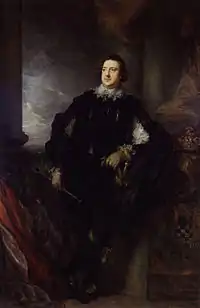Charles Howard, 11th Duke of Norfolk
Charles Howard, 11th Duke of Norfolk (15 March 1746 – 16 December 1815), styled Earl of Surrey from 1777 to 1786, was a British nobleman, peer, and politician. He was the son of Charles Howard, 10th Duke of Norfolk and Catherine Brockholes. Howard was known for actively participating in the Tory party as part of the support for King George III. He also spent a considerable amount of his money rebuilding and refurbishing Arundel Castle after inheriting his title and lands.
Charles Howard | |
|---|---|
| Duke of Norfolk | |
 Painting by Thomas Gainsborough. | |
| Born | 15 March 1746 |
| Died | 16 December 1815 (aged 69) |
| Noble family | Howard |
| Spouse(s) | Marion Coppinger Frances Scudamore |
| Father | Charles Howard, 10th Duke of Norfolk |
| Mother | Catherine Brockholes |
%252C_11th_Duke_of_Norfolk_by_James_Lonsdale.jpg.webp)
by James Lonsdale from the collection of the Gloucester City Museum & Art Gallery
Family
He married, firstly, Marion Coppinger (daughter of John Coppinger), on 1 August 1767, who died a year later giving birth. He married, secondly, Frances Scudamore (1750–1820), the only child of Charles FitzRoy-Scudamore and his wife Frances, formerly Duchess of Beaufort, on 6 April 1771 at London, England. Frances soon became insane after her marriage and was locked away until her death in 1820. Howard then lived with several mistresses. His longtime mistress, Mary Ann Gibbon (a cousin of Edward Gibbon), was reputed to be his secret third wife and she had five children by him, including two sons who were officers of arms, Matthew Howard-Gibbon, and Edward Howard-Gibbon. An older illegitimate son by a previous mistress, Sir William Woods, later became Garter King of Arms.
Politics and letters
Norfolk renounced his Catholicism to start his political life, but remained a staunch supporter of Catholic Emancipation, as well as opposing the war with the American colonies.[1] He sat in Parliament from 1780 to 1784 and became a lord of the treasury in the Portland cabinet in 1783. He succeeded to the title of 11th Duke of Norfolk in 1786 upon the death of his father. Eventually he was dismissed from the lord lieutenancy of the West Riding in 1798 for toasting “Our sovereign’s health—the majesty of the people” in terms displeasing to George III.[2] He was known as the "Architectural Duke" for setting in motion the rebuilding of Arundel Castle, after over one hundred years of neglect, in the regency style. The 15th Duke disliked the 11th Duke's style but left his Library, which is regarded as the best room in the Castle.[3]
Norfolk wrote Historical Anecdotes of some of the Howard Family (1769 and 1817).[2] He was a good friend of Sir Bysshe Shelley, allowing him in 1786 to make out the patent for his baronetcy.[1] Shelley was influenced by Norfolk and built the flamboyant Castle Goring, one side of which was a partial copy of Norfolk's residence of Arundel Castle.[1]
Norfolk died on 16 December 1815 at age 69, without issue from either of his two legal marriages. Upon his death, his lands and titles passed to his cousin, Bernard.
See also
Notes
- Bieri, James; James Bieri, S. (2004). Percy Bysshe Shelley. ISBN 9780874138702.
- Chisholm 1911, p. 744.
- Rines, George Edwin, ed. (1920). . Encyclopedia Americana.
References
- . Dictionary of National Biography. London: Smith, Elder & Co. 1885–1900.
 This article incorporates text from a publication now in the public domain: Chisholm, Hugh, ed. (1911). "Norfolk, Earls and Dukes of". Encyclopædia Britannica. 19 (11th ed.). Cambridge University Press. pp. 742–744.
This article incorporates text from a publication now in the public domain: Chisholm, Hugh, ed. (1911). "Norfolk, Earls and Dukes of". Encyclopædia Britannica. 19 (11th ed.). Cambridge University Press. pp. 742–744.
External links
![]() Media related to Charles Howard, 11th Duke of Norfolk at Wikimedia Commons
Media related to Charles Howard, 11th Duke of Norfolk at Wikimedia Commons
| Parliament of Great Britain | ||
|---|---|---|
| Preceded by Anthony Storer Walter Spencer-Stanhope |
Member of Parliament for Carlisle 1780–1786 With: William Lowther 1780–1784 Edward Norton 1784–1786 John Lowther 1786 John Christian 1786–1790 |
Succeeded by John Christian Edward Knubley |
| Preceded by Thomas Fitzherbert Peter William Baker |
Member of Parliament for Arundel 1784 With: Thomas Fitzherbert |
Succeeded by Thomas Fitzherbert Richard Beckford |
| Political offices | ||
| Preceded by The Earl of Effingham |
Deputy Earl Marshal 1782–1786 |
Vacant |
| Preceded by The Duke of Norfolk |
Earl Marshal 1786–1815 |
Succeeded by The Duke of Norfolk |
| Honorary titles | ||
| Preceded by The Marquess of Rockingham |
Lord Lieutenant of the West Riding of Yorkshire 1782–1798 |
Succeeded by The Earl FitzWilliam |
| Preceded by The Duke of Richmond |
Lord Lieutenant of Sussex 1807–1815 |
Succeeded by The Duke of Richmond |
| Peerage of England | ||
| Preceded by Charles Howard |
Duke of Norfolk 1786–1815 |
Succeeded by Bernard Howard |